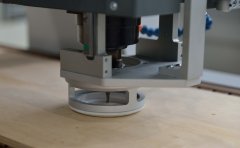The touch scanning head is used, inter alia, to scan details in order to make duplicates or enter into the computer memory for further processing. It allows you to scan uneven surfaces and take into account its deflection when designing.
Creasing head used with the cutting head (electric or pneumatic), allowing for making special presenting creases, mostly on paper, to enable subsequent folding of the material. Typically, the head uses creasing wheels, with different diameters and widths, as well as other tools, eg V-cut heads.
Additional head, mounted next to the cutting / milling head, allowing marking of the workpiece. It has its own actuator, thanks to which it lowers automatically. It can be used both for writing descriptions on details and for drawing given shapes.
Minimum lubrication system with an air-oil mixture supplied to the cutting zone. It replaces traditional, uneconomical cooling systems for the treatment zone based on emulsion solutions. In front of the outlet nozzle, air is mixed in under pressure with oil dispensed in a few drops per minute. The lubrication of the cutting zone with such a mixture is very effective, in addition to increasing the machining efficiency and increasing the tool life, it ensures the maintenance of cleanliness in the manufacturing environment. The cooling activation and deactivation is controlled automatically.
This functionality is most often used in lasers produced by Kimla. A special printing head applies the markings (usually element names) to the material, which allows the identification of cut parts. Functionality, in particular, recommended for companies providing service cutting. although the second possibility is to use the printing system on CNC routers for labeling cut parts in the same way. this allows you to easily recognize the parts after they are milled out.
The pressure foot blocks the possibility of material being pushed up. Useful when cutting parts from thin materials on vacuum suction and vacuum tables.
The spindle cover is mounted on the Z axis. Its task is to reduce dusting and remove chips generated during machining. Useful especially when working in wood, wood-like boards and glass-epoxy laminates. It reduces dust, which improves working conditions and increases the service life of running and driving elements of the machine. The tool is raised automatically for a tool change, but it is also possible to manually set its height.
Spindle cover mounted on the Z axis. Its task is to reduce dusting and extract the chips generated during machining. Particularly useful when working in wood and wood-like panels as well as glass-epoxy laminates. Reduces dust, which improves working conditions and increases service life.
It is a hypertensive device used for the local removal of fine chips or dust generated during the technological processing of, among others, wood, leather, textiles, plastics, etc. materials. In one common housing, there is a transport fan, a simplified cyclone, and a dust collector. The casing is placed on a mobile base that facilitates the movement of the dust collector. The dust collector is equipped as standard.









